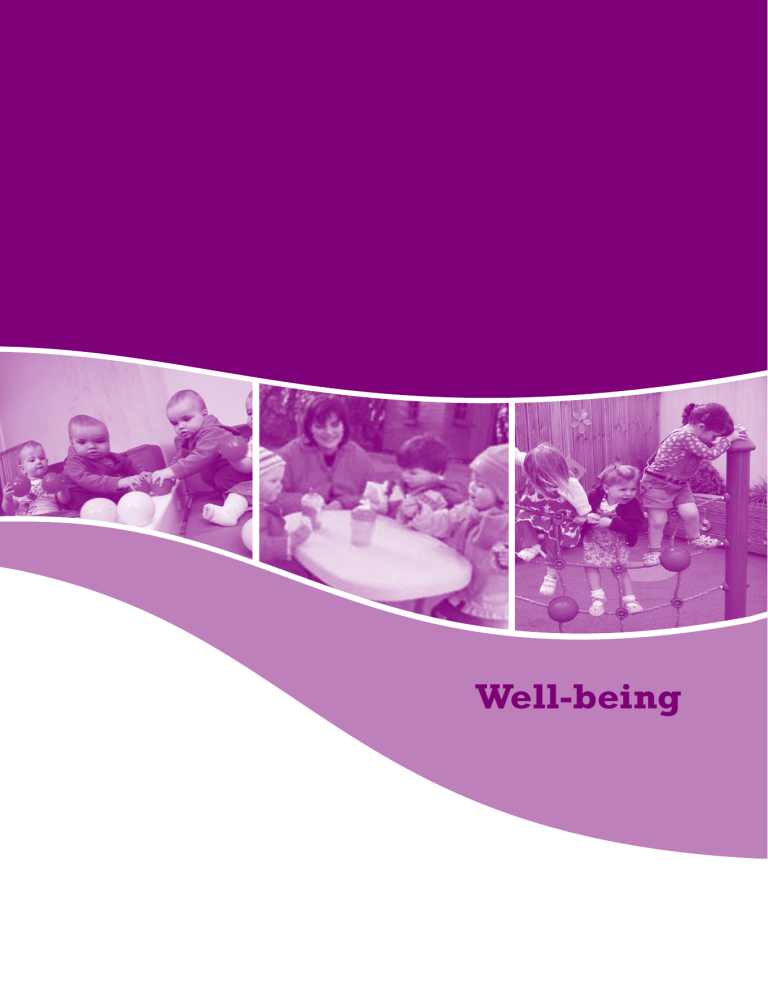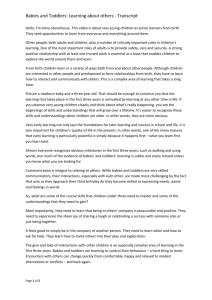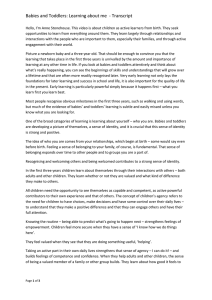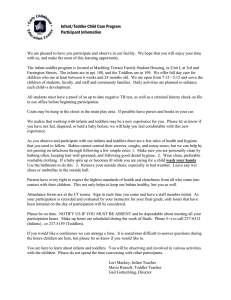Theme: Well

Well-being
Aistear: the Early Childhood Curriculum Framework Well-being
Theme: Well-being
The theme of Well-being is about children being confident, happy and healthy.
Well-being focuses on developing as a person. It has two main elements: psychological well-being (including feeling and thinking) and physical well-being. Children’s relationships and interactions with their families and communities contribute significantly to their sense of well-being. Children need to feel valued, respected, empowered, cared for, and included. They also need to respect themselves, others, and their environment.
They become positive about themselves and their learning when adults value them for who they are and when they promote warm and supportive relationships with them. Expressing themselves creatively and experiencing a spiritual dimension in life enhances children’s sense of well-being. Life is full of challenges and struggles. Therefore, being flexible and having a positive outlook on learning and on life is crucial. All these experiences help children to become resilient and resourceful and to learn to cope with change and situations in which things go wrong.
Physical well-being is important for learning and development as this enables children to explore, to investigate, and to challenge themselves in the environment. A growing awareness of their bodies and abilities is also part of this. The adult supports children’s psychological and physical well-being by helping them to make healthy choices about nutrition, hygiene and exercise. He/she plans for and provides opportunities for children to express themselves, to encourage them to play and work with others, and to deal with challenges. The adult also helps children towards independence by providing them with choice in their activities, and by providing opportunities for them to make decisions and to take the lead.
16
Aistear: the Early Childhood Curriculum Framework Well-being
Table 1: Aims and learning goals for Well-being
Well-being
Aims
Aim 1
Children will be strong psychologically and socially.
Learning goals
In partnership with the adult, children will
1. make strong attachments and develop warm and supportive relationships with family, peers and adults in out-of-home settings and in their community
2. be aware of and name their own feelings, and understand that others may have different feelings
3. handle transitions and changes well
4. be confident and self-reliant
5. respect themselves, others and the environment
6. make decisions and choices about their own learning and development.
Aim 2
Children will be as healthy and fit as they can be.
In partnership with the adult, children will
1. gain increasing control and co-ordination of body movements
2. be aware of their bodies, their bodily functions, and their changing abilities
3. discover, explore and refine gross and fine motor skills
4. use self-help skills in caring for their own bodies
5. show good judgement when taking risks
6. make healthy choices and demonstrate positive attitudes to nutrition, hygiene, exercise, and routine.
Aim 3
Children will be creative and spiritual.
In partnership with the adult, children will
1. express themselves creatively and experience the arts
2. express themselves through a variety of types of play
3. develop and nurture their sense of wonder and awe
4. become reflective and think flexibly
5. care for the environment
6. understand that others may have beliefs and values different to their own.
Aim 4
Children will have positive outlooks on learning and on life.
In partnership with the adult, children will
1. show increasing independence, and be able to make choices and decisions
2. demonstrate a sense of mastery and belief in their own abilities and display learning dispositions, such as determination and perseverance
3. think positively, take learning risks, and become resilient and resourceful when things go wrong
4. motivate themselves, and welcome and seek challenge
5. respect life, their own and others, and know that life has a meaning and purpose
6. be active citizens.
17
Aistear: the Early Childhood Curriculum Framework
Sample learning opportunities
Babies
The adult
■■ engages with babies in a consistent, calm, caring and respectful manner:
➜■ knows babies well, responds appropriately to them and provides a secure base from which they can play and explore
➜■
➜■
➜■
➜■ communicates positively with babies using eye contact, touch, and a soft tone of voice sets up relaxed routines for feeding, toileting, sleeping and play activities, and interacts with and talks to the babies during these routines has routines for change-over and transition times, for example waving bye-bye, placing a favourite toy in a ‘special’ place, saying the babies’ names on arrival shares information regularly to get to know more about babies’ home and out-of-home experiences
■■ enables babies to explore and manipulate objects in a multisensorial way so that they can smell, taste, hear, see, touch, reach, grasp, lift, and drop objects:
➜■ provides a variety of items and materials that are safe for babies to play with, for example things that are hard, soft, natural, and manmade
➜■ encourages and helps babies to strengthen muscles by placing them in different positions, for example lying on their tummies, lifting their heads to see around them, sitting propped up by cushions, lying on their backs under a mobile
■■ encourages babies to do things for themselves , encourages their initiatives and choices, and reacts positively to their endeavours so that they develop positive dispositions to learning:
➜■ assists, encourages and affirms babies’ efforts, for example says, Look, you’re drinking your milk all by yourself , or claps hands when the baby turns the pages of a book
➜■
➜■ acknowledges and encourages babies’ persistence, for example provides physical support as they attempt to stand, walk, or put shapes in a shape sorter describes babies’ activities and affirms their efforts
■■ nurtures babies’ sense of wonder :
➜■ gives babies experiences of the natural environment outdoors and describes the experiences, for example touching flowers and leaves, looking at spiders’ webs, watching, listening to and touching running water, and playing with snow
➜■ places natural items such as stones, wooden items, wool, and felt in a basket for exploration, or models splashing water in the bath or sink
➜■ interacts with babies in a quiet area, for example the baby sitting on the adult’s lap to gaze about the room or to listen to a piece of gentle music, while the adult responds to the baby’s communicative efforts or quietly describes what the baby is focusing on
18
Well-being
Aistear: the Early Childhood Curriculum Framework Well-being
■■ facilitates repetition and challenge so that babies can master and extend what they are doing, while encouraging them to take risks :
➜■ challenges babies to try new things, for example offers new toys or materials, hides objects leaving part of the toy visible in the beginning, puts the toy just out of reach so that the babies have to crawl or reach to get it
➜■
➜■ introduces babies to different play areas indoors and outdoors, for example gives babies access to steps or ramps to experience different levels, waits nearby as the babies crawl up steps, kneels down to look into a tunnel so that the babies can see him/her encourages repetition of activities so that babies can master them, and repeats vocalisations and sounds
■■ helps babies to respect themselves and others:
➜■ helps babies discover they are unique people, for example places mirrors and photos at babies’ level, uses babies’ names often
➜■
➜■ creates opportunities for babies to be with other babies and older children, with the adult talking about who is there and what is happening affirms babies’ behaviour, saying, for example, Well done, you are helping Mammy tidy the toys back in the box or You are giving your teddy a lovely cuddle.
Toddlers
The adult
■■ ensures that toddlers get adequate rest, nutrition and stimulation :
➜■ enables toddlers to develop and/or continue routines around eating, sleeping and hygiene, keeping their families informed of routines
➜■
➜■ encourages healthy eating and helps toddlers to become aware of different food types and their benefits, for example that milk is good for bones and teeth, and that fruit and vegetables are good for healthy bodies incorporates sleeping times into the daily routine for those who need it
■■ provides toddlers with a well-structured and orderly environment and a predictable but flexible routine :
➜■ helps toddlers to anticipate familiar events, for example uses signals to show when the present activity is going to end and tells them what is going to happen next:
Soon we will be putting away the bricks and tidying up before story time or We’re going to put on coats now before going outside
➜■ structures the environment by storing things in familiar places, for example a toybox in the bedroom or dividing the space into interest areas such as quiet, messy, pretend play, and so on, so that toddlers know where to find things
■■ enables toddlers to become independent :
➜■ shows toddlers how to do things, for example getting their cups from the cupboard, lifting a chair, caring for a plant, putting their blanket on their bed, filling the washing machine, sweeping the floor
19
Aistear: the Early Childhood Curriculum Framework Well-being
➜ ■
➜ ■ encourages and enables toddlers to do things for themselves by developing selfcare skills, for example washing and drying hands, getting dressed, becoming toilet trained, putting on wellingtons encourages toddlers to make choices, saying, for example, Would you like an apple or an orange? Do you want to wear the red socks or the blue socks? Which story would you like before bedtime? Whose hand will you take, mine or Aileen’s?
■■ encourages toddlers to solve problems and to think about different ways of doing things:
➜■ acknowledges and encourages toddlers’ problem-solving efforts, saying, for example, Oh, I see, you pulled up your sleeve because you wanted to play with the water or Great, you are helping sweep up the sand that fell on the floor
➜■ gives toddlers reasons and choices when they have to do something, saying, for example , I need to change your nappy because it is dirty. Will you get the clean nappy or will I? We can go outside in the rain when you put on your coat and wellies. You want the car that Laura is playing with – why don’t we find another one like it?
■■ provides lots of opportunities to strengthen toddlers’ muscles , to refine skills and to enhance hand-eye co-ordination:
➜■ discovers with toddlers how their bodies work by finding out what different body parts do and what sounds they make, for example stretching, balancing, listening to their breathing, throwing and catching items, kicking a ball, using a climbing frame
➜■ ensures there are lots of opportunities for toddlers to take part in a variety of types of play regardless of gender or ability
■■ collaborates with toddlers in experiencing and caring for the environment :
➜■ provides opportunities for toddlers to enjoy and learn about the natural environment, for example stamping in puddles, digging, recycling, sweeping, making art with natural materials, going for walks, planting, hunting for creatures such as worms, ladybirds, spiders, caterpillars, observing and finding out about them
➜■
➜■
➜■ provides adequate outdoor clothing so that toddlers can play outside regardless of the weather takes toddlers on trips, for example visiting an open farm to see the animals or going to a garden to experience different smells and colours and feel different textures takes photographs of the outdoors, displaying them at child level and using them to start discussions
■■ encourages toddlers to act on their curiosity , to take risks , to concentrate , and to be resilient:
➜■ provides opportunities for toddlers to try things out and to see what happens, for example when they add water to soil, when they mix different coloured paints together, or when they make ramps for a toy tractor or tricycle
➜■ helps toddlers’ concentration by creating quiet zones and reducing background noise, ensures toddlers are not disturbed unnecessarily when they are absorbed in a task, and provides tasks and activities linked to their interests
20
Aistear: the Early Childhood Curriculum Framework Well-being
➜ ■
➜ ■ encourages toddlers to take risks, for example climbing to the top of the slide, trying a new food, getting an object from the top shelf helps toddlers to look on things positively even when things don’t go as they plan, for example when the tower they are building falls down or when they can’t have the toy or snack they want.
Young children
The adult
■ ■ helps young children to predict and cope with changes, transitions and stressful life events :
➜ ■ helps children to share their emotions non-verbally and verbally with others and to develop coping skills such as asking for help, talking about what has happened, or talking about what is going to happen: Where are we going after dinner? Would you like to hold the teddy while you are waving goodbye to Dad? If you are afraid come and tell me.
➜ ■ helps children to become aware of what happens in their bodies when they become upset, frightened and angry, for example fluttering tummy, sweaty palms, dry mouth
➜ ■
➜ ■ comforts children during separation, for example staying with them, looking at family photographs, doing a favourite activity together, playing in a favourite place talks to children about transitions such as starting pre-school or primary school, staying overnight with other family members, moving to a new house, welcoming a new baby into the family
■ ■ approaches conflict situations calmly, models positive behaviour ,and creates opportunities for children to share and take turns:
➜ ■ provides adequate resources so that children don’t have to wait too long to get their turn, for example encouraging children to use strategies like asking for a turn, using an egg-timer to time each turn, or drawing up a waiting list and encouraging children to tick themselves off the list as they take their turn
➜ ■
➜ ■ uses a problem-solving approach to respond to social conflicts, for example asking children what happened or what the problem is, restating the problem, helping children to find a solution, providing subsequent support and ensuring all involved are supported, comforted and reassured uses ‘I statements’ to focus on the problem not the person, saying, for example,
I feel worried when you do that because you might hurt yourself or I know you are really cross with Dwayne for taking the truck
➜ ■
➜ ■ speaks calmly, models being polite, says please, thank you and excuse me, offers explanations and gives reasons for actions uses rotas so that everyone in a group or family gets a chance to do things, for example handing out lunches, tidying up the book corner, being first to do or get something
21
Aistear: the Early Childhood Curriculum Framework Well-being
■■ promotes good health and encourages children to make healthy choices:
➜■ models and encourages exercising, taking care of teeth, washing hands, using their own hair brushes, using tissues to clean their noses
➜■
➜■ encourages children to refine their self-care and self-help skills such as using cutlery, fastening buttons, putting on shoes, making lunch, packing their bags provides food choices at snack-times and lunch-times to extend children’s knowledge and experience of a range of healthy food options from different cultures
➜■
➜■ discusses food, where it comes from, how it is prepared, and how it is cooked and eaten, encouraging children to take part in cooking and food preparation as appropriate, for example buttering toast, chopping up bananas, picking strawberries, gathering herbs and vegetables from the garden includes physical activities in the daily routine to help build children’s fitness
■■ listens to and discusses things in depth with children:
➜■ listens attentively to what children are saying and also to what they are not saying
➜■ encourages thinking together in small groups by making open-ended statements and asking open-ended questions, saying, for example, What would happen if …
I wonder why … What do you think about …
➜■
➜■ discusses children’s profound questions in a secure and reassuring manner, for example,
Why was I born? Why did granny die? If the world is round why don’t we fall off when it moves around? Does the world go on forever? Who named the days of the week? Why is my Mario’s skin black? Why can’t Enya speak English? Why don’t Anto’s legs work properly?
raises awareness about a diversity of beliefs, for example that many people have a concept of God or of a being greater than themselves, that some people don’t share this belief
■■ plans quiet times and sets up a space for thinking and reflecting :
➜■ encourages children to reflect on what they have done or to observe the detail in something such as a leaf or a flower
➜■ introduces children to relaxation strategies, for example asking children to concentrate on breathing and inviting them to listen to a piece of music
➜■
➜■ ensures children who need some peace and quiet are not disturbed builds sleeping times into routines for children who need them and provides appropriate place for sleeping
22
Aistear: the Early Childhood Curriculum Framework Well-being
■■ explores and promotes the concept of citizenship and social justice with children and respects them as young citizens:
➜■ ensures play is a fair and positive experience for all children
➜■
➜■ introduces games with rules, for example card and board games, hopscotch, football, parachute game (trying to make a ball fall over the edge of a large sheet held by members of two teams) discusses important issues with children, for example a newspaper article that might interest them, or concepts like fairness, power, responsibility, freedom, rights, or prejudice in the context of children’s daily experiences
➜■
➜■
➜■
➜■ involves children in decision making and rule making, for example consulting with them on rules for talking and listening or turn-taking and exploring why the rules are important provides children with choices, saying, for example, What would you like to do this morning? What story will we read? And inviting the children to vote or to reach a consensus ensures all children can participate in negotiations, for example helping shy and quiet children to partake nurtures children’s sense of empathy and fairness by encouraging and supporting discussion when issues arise
■■ appreciates children’s efforts , identifies their individual strengths and abilities and helps them to cope and to try again when they experience failure:
➜■ observes children closely so that he/she knows what their interests and strengths are, and builds on these
➜■
➜■
➜■ encourages children to use their many abilities and strengths, for example getting along with others, being artistic or musical, taking part in sports, enjoying reading helps children to reflect on their achievements and interests and to identify personal goals, saying, for example,
What can you do now that you couldn’t last year or when you were a baby? What would you like to be able to do at your next birthday? What is your favourite activity? Why?
models strategies to help children persevere in the face of difficulty, for example what to do when the jigsaw piece won’t fit or when the sand-castle collapses.
23



